Characteristics of the Soil Organic Carbon Pool in Paddy Fields in Guangdong Province, South China
Abstract
:1. Introduction
2. Materials and Methods
2.1. Study Area
2.2. Sample Collection
2.3. Soil Analysis
2.3.1. Basic Physicochemical Properties
2.3.2. Soil Organic Carbon Fractions
2.4. Soil Carbon Stocks
2.5. Statistical Analysis
3. Results
3.1. Soil Properties
3.2. Soil Total Organic Carbon (SOC)
3.3. Soil Organic C Fractions
3.3.1. Labile Organic Carbon Fraction I (LOCF-I)
3.3.2. Soil Labile Organic Carbon Fraction II
3.3.3. Soil Recalcitrant Organic Carbon (ROC)
3.4. Composition of Soil Organic Carbon Pool
3.5. Correlations between Soil Organic C Concentrations and Soil Properties
3.5.1. Correlation Analysis
3.5.2. Path Analysis
4. Discussion
5. Conclusions
Author Contributions
Funding
Institutional Review Board Statement
Data Availability Statement
Conflicts of Interest
References
- Crowther, T.W.; Todd-Brown, K.E.; Rowe, C.W.; Wieder, W.R.; Carey, J.C.; Machmuller, M.B.; Snoek, B.L.; Fang, S.; Zhou, G.; Allison, S.D.; et al. Quantifying global soil carbon losses in response to warming. Nature 2016, 540, 104–108. [Google Scholar] [CrossRef]
- Hicks Pries, C.E.; Castanha, C.; Porras, R.C.; Torn, M.S. The whole-soil carbon flux in response to warming. Science 2017, 355, 1420–1423. [Google Scholar] [CrossRef] [PubMed]
- Zhou, Z.; Zeng, X.; Chen, K.; Li, Z.; Guo, S.; Shangguan, Y.; Yu, H.; Tu, S.; Qin, Y. Long-term straw mulch effects on crop yields and soil organic carbon fractions at different depths under a no-till system on the Chengdu Plain, China. J. Soils Sediments 2019, 19, 2143–2152. [Google Scholar] [CrossRef]
- Lee, X.; Huang, Y.; Huang, D.; Hu, L.; Feng, Z.; Cheng, J.; Wang, B.; Ni, J.; Shurkhuu, T. Variation of Soil Organic Carbon and Its Major Constraints in East Central Asia. PLoS ONE 2016, 11, e0150709. [Google Scholar] [CrossRef]
- Smith, P.; Trines, E. Commentary: Agricultural measures for mitigating climate change: Will the barriers prevent any benefits to developing countries? Int. J. Agric. Sustain. 2011, 4, 173–175. [Google Scholar] [CrossRef]
- Feng, S.; Tan, S.; Zhang, A.; Zhang, Q.; Pan, G.; Qu, F.; Smith, P.; Li, L.; Zhang, X. Effect of household land management on cropland topsoil organic carbon storage at plot scale in a red earth soil area of South China. J. Agric. Sci. 2011, 149, 557–566. [Google Scholar] [CrossRef] [PubMed]
- Zhao, Z.; Zhao, Z.; Fu, B.; Wang, J.; Tang, W. Characteristics of soil organic carbon fractions under different land use patterns in a tropical area. J. Soils Sediments 2020, 21, 689–697. [Google Scholar] [CrossRef]
- Hua, K.; Wang, D.; Guo, X.; Guo, Z. Carbon sequestration efficiency of organic amendments in a long-term experiment on a vertisol in Huang-Huai-Hai Plain, China. PLoS ONE 2014, 9, e108594. [Google Scholar] [CrossRef]
- Lal, R. Offsetting China’s CO2 Emissions by Soil Carbon Sequestration. Clim. Chang. 2004, 65, 263–275. [Google Scholar] [CrossRef]
- Zomer, R.J.; Bossio, D.A.; Sommer, R.; Verchot, L.V. Global sequestration potential of increased organic carbon in cropland soils. Sci. Rep. 2017, 7, 15554. [Google Scholar] [CrossRef]
- Tang, J.; Liu, T.; Yang, J.; Nie, J.; Xing, J.; Zhang, L.; Zhang, W.; Tang, W.; Cao, C. Current status of carbon neutrality in Chinese rice fields (2002-2017) and strategies for its achievement. Sci Total Environ. 2022, 842, 156713. [Google Scholar] [CrossRef]
- Arachchige, P.S.P.; Hettiarachchi, G.M.; Rice, C.W.; Dynes, J.J.; Maurmann, L.; Wang, J.; Karunakaran, C.; Kilcoyne, A.L.D.; Attanayake, C.P.; Amado, T.J.C.; et al. Sub-micron level investigation reveals the inaccessibility of stabilized carbon in soil microaggregates. Sci. Rep. 2018, 8, 16810. [Google Scholar] [CrossRef]
- Di, J.; Xu, M.; Zhang, W.; Tong, X.; He, X.; Gao, H.; Liu, H.; Wang, B. Combinations of soil properties, carbon inputs and climate control the saturation deficit dynamics of stable soil carbon over 17-year fertilizaiton. Sci. Rep. 2018, 8, 12653. [Google Scholar] [CrossRef]
- Sahoo, U.K.; Singh, S.L.; Gogoi, A.; Kenye, A.; Sahoo, S.S. Active and passive soil organic carbon pools as affected by different land use types in Mizoram, Northeast India. PLoS ONE 2019, 14, 0219969. [Google Scholar] [CrossRef]
- Pan, S.; Shi, J.; Peng, Y.; Wang, Z.; Wang, X. Soil organic carbon pool distribution and stability with grazing and topography in a Mongolian grassland. Agric. Ecosyst. Environ. 2023, 348, 108431. [Google Scholar] [CrossRef]
- Ji, H.; Han, J.; Xue, J.; Hatten, J.A.; Wang, M.; Guo, Y.; Li, P. Soil organic carbon pool and chemical composition under different types of land use in wetland: Implication for carbon sequestration in wetlands. Sci. Total Environ. 2020, 716, 136996. [Google Scholar] [CrossRef]
- Rovira, P.; Vallejo, V.R. Labile and recalcitrant pools of carbon and nitrogen in organic matter decomposing at different depths in soil: An acid hydrolysis approach. Geoderma 2002, 107, 109–141. [Google Scholar] [CrossRef]
- Purakayastha, T.J.; Rudrappa, L.; Singh, D.; Swarup, A.; Bhadraray, S. Long-term impact of fertilizers on soil organic carbon pools and sequestration rates in maize–wheat–cowpea cropping system. Geoderma 2008, 144, 370–378. [Google Scholar] [CrossRef]
- Hassan, W.; Bashir, S.; Ahmed, N.; Tanveer, M.; Shah, A.N.; Bano, R.; David, J. Labile Organic Carbon Fractions, Regulator of CO2 Emission: Effect of Plant Residues and Water Regimes. CLEAN-Soil Air Water 2016, 44, 1358–1367. [Google Scholar] [CrossRef]
- Wang, Y.; Gu, J.; Ni, J. Influence of biochar on air permeability and greenhouse gas emission in a vegetated soil: A review. Biogeotechnics 2023, 1, 100040. [Google Scholar] [CrossRef]
- Ni, J.; Zhou, J.; Wang, Y. Gas permeability and emission in unsaturated vegetated landfill cover with biochar addition. Biochar 2023, 5, 47. [Google Scholar] [CrossRef]
- Blazier, M.A.; Liechty, H.O. Assessment of Labile Organic Carbon in Soil Using Sequential Fumigation Incubation Procedures. J. Vis. Exp. 2016, 116, 54614. [Google Scholar] [CrossRef]
- Yagi, K.; Minami, K. Effect of organic matter application on methane emission from some Japanese paddy fields. Soil Sci. Plant Nutr. 1990, 36, 599–610. [Google Scholar] [CrossRef]
- Coxall, H.K.; Wilson, P.A.; Palike, H.; Lear, C.H.; Backman, J. Rapid stepwise onset of Antarctic glaciation and deeper calcite compensation in the Pacific Ocean. Nature 2005, 433, 53–57. [Google Scholar] [CrossRef]
- von Lützow, M.; Kögel-Knabner, I.; Ekschmitt, K.; Flessa, H.; Guggenberger, G.; Matzner, E.; Marschner, B. SOM fractionation methods:Relevance to functional pools and to stabilization mechanisms. Soil Biol. Biochem. 2007, 39, 2183–2207. [Google Scholar] [CrossRef]
- Zhang, H.; Zhou, Z. Recalcitrant carbon controls the magnitude of soil organic matter mineralization in temperate forests of northern China. For. Ecosyst. 2018, 5, 17. [Google Scholar] [CrossRef]
- Li, S.; Zhang, S.; Pu, Y.; Li, T.; Xu, X.; Jia, Y.; Deng, O.; Gong, G. Dynamics of soil labile organic carbon fractions and C-cycle enzyme activities under straw mulch in Chengdu Plain. Soil Tillage Res. 2016, 155, 289–297. [Google Scholar] [CrossRef]
- Wang, H.; Guan, D.; Zhang, R.; Chen, Y.; Hu, Y.; Xiao, L. Soil aggregates and organic carbon affected by the land use change from rice paddy to vegetable field. Ecol. Eng. 2014, 70, 206–211. [Google Scholar] [CrossRef]
- Zhou, J.; Tang, C.; Kuzyakov, Y.; Vancov, T.; Fang, Y.; Song, X.; Zhou, X.; Jiang, Z.; Ge, T.; Xu, L.; et al. Biochar-based urea increases soil methane uptake in a subtropical forest. Geoderma 2024, 449, 116994. [Google Scholar] [CrossRef]
- Walkley, A.; Black, I.A. An Examination of the Degtjareff Method for Determining Soil Organic Matter, and a Proposed Modification of the Chromic Acid Titration Method. Soil Sci. 1934, 37, 29–38. [Google Scholar] [CrossRef]
- Lu, R.K. Analysis Methods of Agricultural Chemistry of Soil; China Agricultural Science and Technology Press: Beijing, China, 2000. [Google Scholar]
- Novara, A.; Poma, I.; Sarno, M.; Venezia, G.; Gristina, L. Long-Term Durum Wheat-Based Cropping Systems Result in the Rapid Saturation of Soil Carbon in the Mediterranean Semi-arid Environment. Land Degrad. Dev. 2016, 27, 612–619. [Google Scholar] [CrossRef]
- Wu, X.; Liu, P.; Wegner, C.E.; Luo, Y.; Xiao, K.Q.; Cui, Z.; Zhang, F.; Liesack, W.; Peng, J. Deciphering microbial mechanisms underlying soil organic carbon storage in a wheat-maize rotation system. Sci. Total Environ. 2021, 788, 147798. [Google Scholar] [CrossRef]
- Ren, F.; Zhang, X.; Liu, J.; Sun, N.; Wu, L.; Li, Z.; Xu, M. A synthetic analysis of greenhouse gas emissions from manure amended agricultural soils in China. Sci. Rep. 2017, 7, 8123. [Google Scholar] [CrossRef]
- National Soil Census Office. China Soil Census Technology; Agriculture Press: Beijing, China, 1990. [Google Scholar]
- Soil Census Office of Guangdong Province. Guangdong Soil; Science Press: Beijing, China, 1993. [Google Scholar]
- Zhu, L.; Hu, N.; Zhang, Z.; Xu, J.; Tao, B.; Meng, Y. Short-term responses of soil organic carbon and carbon pool management index to different annual straw return rates in a rice-wheat cropping system. Catena 2015, 135, 283–289. [Google Scholar] [CrossRef]
- Chen, S.; Xia, X.; Ding, Y.; Feng, X.; Lin, Q.; Li, T.; Bian, R.; Li, L.; Cheng, K.; Zheng, J.; et al. Changes in aggregate-associated carbon pools and chemical composition of topsoil organic matter following crop residue amendment in forms of straw, manure and biochar in a paddy soil. Geoderma 2024, 448, 116967. [Google Scholar] [CrossRef]
- Huang, Q.Y.; Yu, J.H.; Huang, J.F.; Huang, X.; Li, P.; Fu, H.; Tang, S.; Liu, Y.; Xu, P. Nutrient Resources of Main Crop Straw and Its Potential of Substituting for Chemical Fertilizer in Guangdong Province. Ecol. Environ. Sci. 2022, 31, 297–306. [Google Scholar]
- National Bureau of Statistics of China. Guangdong Statistical Yearbook of Agriculture 2021; China Statistics Press: Beijing, China, 2021. [Google Scholar]
- Zhang, Y.; Wang, P.; Liu, Y.; Wang, J. Effects of Long-term Crop Cultivation on Soil Organic Carbon in China’s Farmland: A Meta-Analysis. Acta Pedol. Sin. 2024, 61. [Google Scholar] [CrossRef]
- Yin, S.; Wang, J.; Yu, T.; Wang, M.; Wu, Y.; Zeng, H. Constraints on the spatial variations of soil carbon fractions in a mangrove forest in Southeast China. Catena 2023, 222, 106889. [Google Scholar] [CrossRef]
- Li, M.; Bai, L.; Yang, L.; Wang, Q.; Zhu, J. Amount, distribution and controls of the soil organic carbon storage loss in the degraded China’s grasslands. Sci. Total Environ. 2024, 944, 173848. [Google Scholar] [CrossRef]
- Li, Q.-W.; Zhang, X.-Y.; Gao, J.-Q.; Rinnan, R.; Jiao, Y.; Liang, J.-F.; Yu, F.-H. Precipitation patterns impact soil aggregates and organic carbon of an alpine wetland on the Qinghai-Tibetan Plateau. Catena 2024, 244, 108249. [Google Scholar] [CrossRef]
- Li, G.; Sun, S.; Lu, N.; Huang, R.; Yan, J.; Song, F.; Han, J.; Wang, Y. Changes in soil organic carbon stocks of forestlands and grasslands on the Loess Plateau, 1980–2015. J. Clean. Prod. 2023, 428, 139463. [Google Scholar] [CrossRef]
- Wang, H.F.; Wu, Y.H.; Zhang, R.; An, J.; Zhang, Y.; Yu, N.; Zou, T. Effect of Rice Straw Addition on CH4 Emission in BlackSoil with Different Rice Planting Years. Chin. J. Soil Sci. 2022, 53, 1421–1429. [Google Scholar] [CrossRef]
- Li, X.-Z.; Han, B.-S.; Yang, F.; Hu, C.-Y.; Han, G.-Z.; Huang, L.-M. Effects of land use change on soil carbon and nitrogen in purple paddy soil. J. Environ. Manag. 2022, 314, 115122. [Google Scholar] [CrossRef]
- Shen, Z.; Han, T.; Huang, J.; Li, J.; Daba, N.A.; Gilbert, N.; Khan, M.N.; Shah, A.; Zhang, H. Soil organic carbon regulation by pH in acidic red soil subjected to long-term liming and straw incorporation. J. Environ. Manag. 2024, 367, 122063. [Google Scholar] [CrossRef]
- Li, Y. Distribution of Soil Organic Carbon and Its Affecting Factors under Different Land Utilization Patterns—Taking East of Hainan Island as an Example. Master’s Dissertation, Hainan Normal University, Haikou, China, 2018. [Google Scholar]
- Ci, E.; Yang, L.; Ma, L.; Gao, M. Characteristics of organic matters in paddy soils derived from dark brown soil and red soil. Acta Pedol. Sin. 2009, 46, 1162–1167. [Google Scholar] [CrossRef]
- Heckman, K.; Pries, C.E.H.; Lawrence, C.R.; Rasmussen, C.; Crow, S.E.; Hoyt, A.M.; von Fromm, S.F.; Shi, Z.; Stoner, S.; McGrath, C.; et al. Beyond bulk: Density fractions explain heterogeneity in global soil carbon abundance and persistence. Global Chang. Biol. 2021, 28, 1178–1196. [Google Scholar] [CrossRef] [PubMed]
- Parton, W.J.; Schimel, D.S.; Cole, C.V.; Ojima, D.S. Analysis of factors controlling soil organic matter levels in great plains grasslands. Soil Sci. Soc. Am. J. 1987, 51, 1173–1179. [Google Scholar] [CrossRef]
- Paul, E.; Collins, H.; Leavitt, S. Dynamics of resistant soil carbon of midwestern agricultural soils measured by naturally occurring 14C abundance. Geoderma 2001, 104, 239–256. [Google Scholar] [CrossRef]
- Liao, D.; Yu, D.; Zhao, Y.; Wang, N.; Zhang, H.; Pan, J.; Shi, X. Composition of organic carbon in paddy soil in typical area of Chengdu and its influencing factors. Acta Pedol. Sin. 2015, 52, 517–527. [Google Scholar] [CrossRef]
- Wu, Z.; Ma, S.; Lu, J.; Yang, D.; Hong, M. Responses of Soil Organic Carbon Components to Long-term Nitrogen Addition in the Stipa baicalensis Meadow Steppe. Acta Pedol. Sin. 2023, 60, 1520–1530. [Google Scholar] [CrossRef]
- Zhang, A.; Zheng, Z.-X.; Zhao, Z.-Y.; Feng, T.-Y.; Zheng, W.; Zhai, B.-N. Effects of long-term combined application of organic and inorganic fertilizers on soil carbon pool and greenhouse gas emissions in orchards. Environ. Sci. 2023, 44, 5823–5831. [Google Scholar]
- Du, X.; Xu, Z.; Lv, Q.; Meng, Y.; Wang, Z.; Feng, H.; Ren, X.; Hu, S.; Gao, Z. Fractions, stability, and influencing factors of soil organic carbon under different land-use in sodic soils. Geoderma Reg. 2022, 31, e00590. [Google Scholar] [CrossRef]
- Jobbágy, E.G.; Jackson, R.B. The vertical distribution of soil organic carbon and its relation to climate and vegetation. Ecol. Appl. 2000, 10, 423–436. [Google Scholar] [CrossRef]
- Fu, Y.; Hu, Z.; Zhu, Q.; Rong, Y. Characteristics of labile organic carbon fractions under different types of subsidence waterlogging areas in a coal mining area: A case study in Xinglongzhuang Coal Mine, China. Catena 2023, 232, 107398. [Google Scholar] [CrossRef]
- Yang, L.; Song, X.; Lyu, S.; Shen, W.; Gao, Y. Dynamics and fractions of soil organic carbon in response to 35 years of aforestation in subtropical China. Plant Soil 2024, 500, 481–494. [Google Scholar] [CrossRef]
- Kida, M.; Watanabe, I.; Kinjo, K.; Kondo, M.; Yoshitake, S.; Tomotsune, M.; Iimura, Y.; Umnouysin, S.; Suchewaboripont, V.; Poungparn, S.; et al. Organic carbon stock and composition in 3.5-m core mangrove soils (Trat, Thailand). Sci. Total Environ. 2021, 801, 149682. [Google Scholar] [CrossRef]
- Zhang, H.; Lin, C.; Cheng, H.; Jin, C.; Xu, Z.; Wei, Z.; Ma, Z. Variation of soil organic carbon content of Moso bamboo forest along altitudinal gradient in Wuyi Mountain in China. Soils 2019, 51, 821–828. [Google Scholar] [CrossRef]
- Mao, H.R.; Francesca Cotrufo, M.; Hart, S.C.; Sullivan, B.W.; Zhu, X.; Zhang, J.; Liang, C.; Zhu, M. Dual role of silt and clay in the formation and accrual of stabilized soil organic carbon. Soil Biol. Biochem. 2024, 192, 109390. [Google Scholar] [CrossRef]
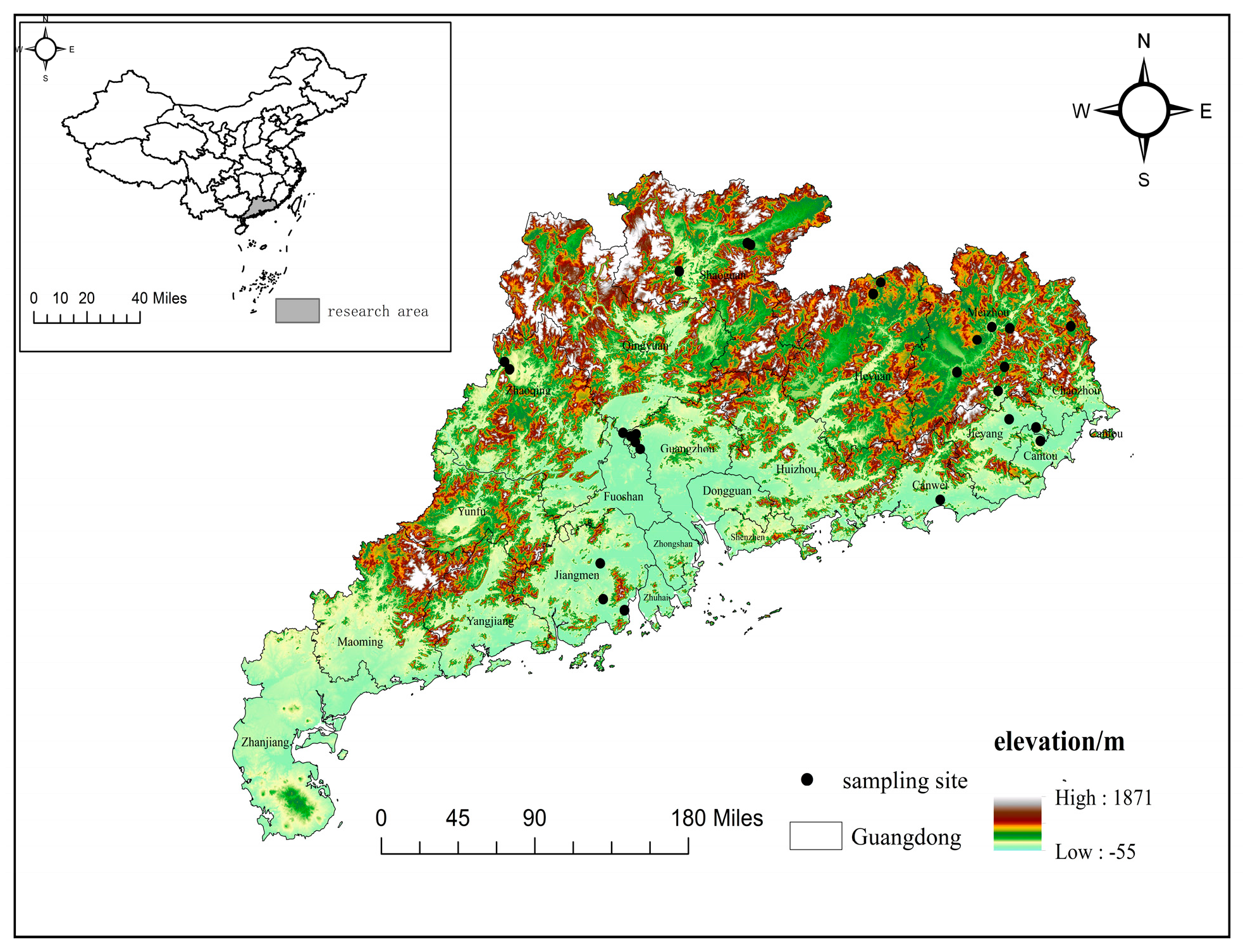
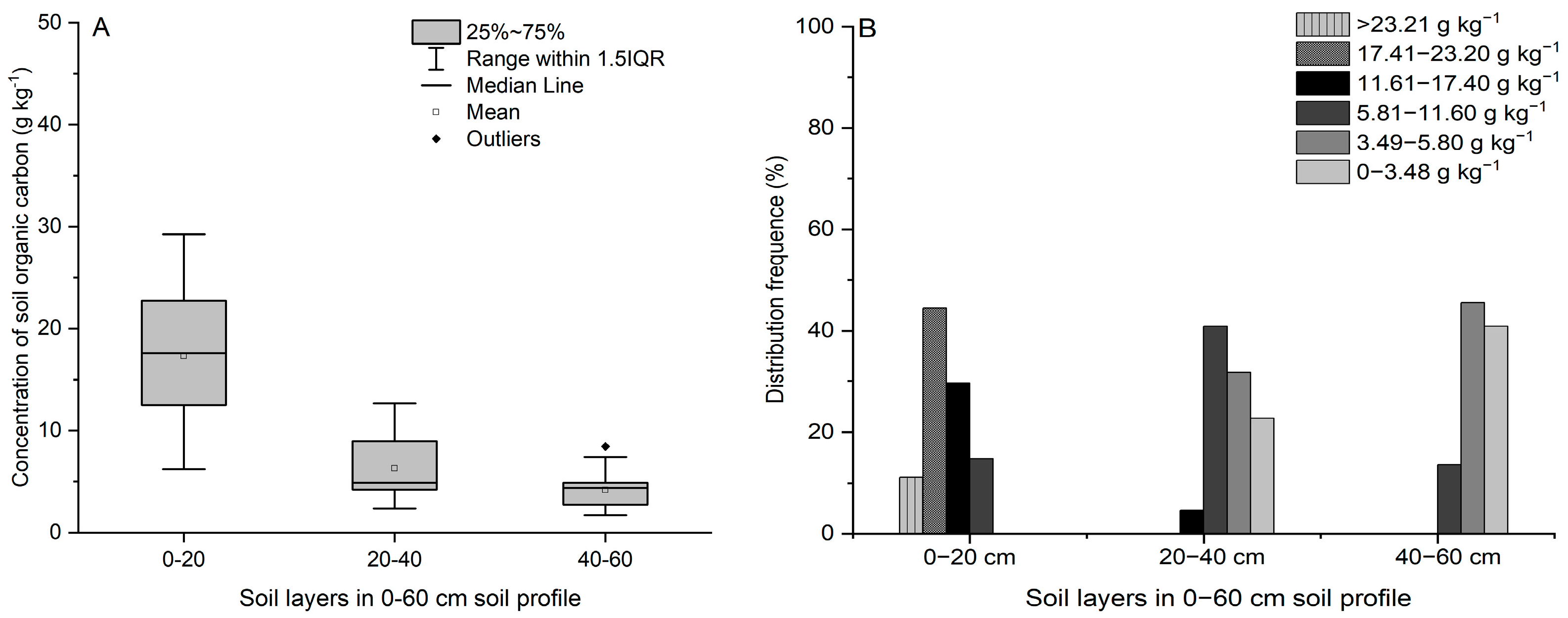

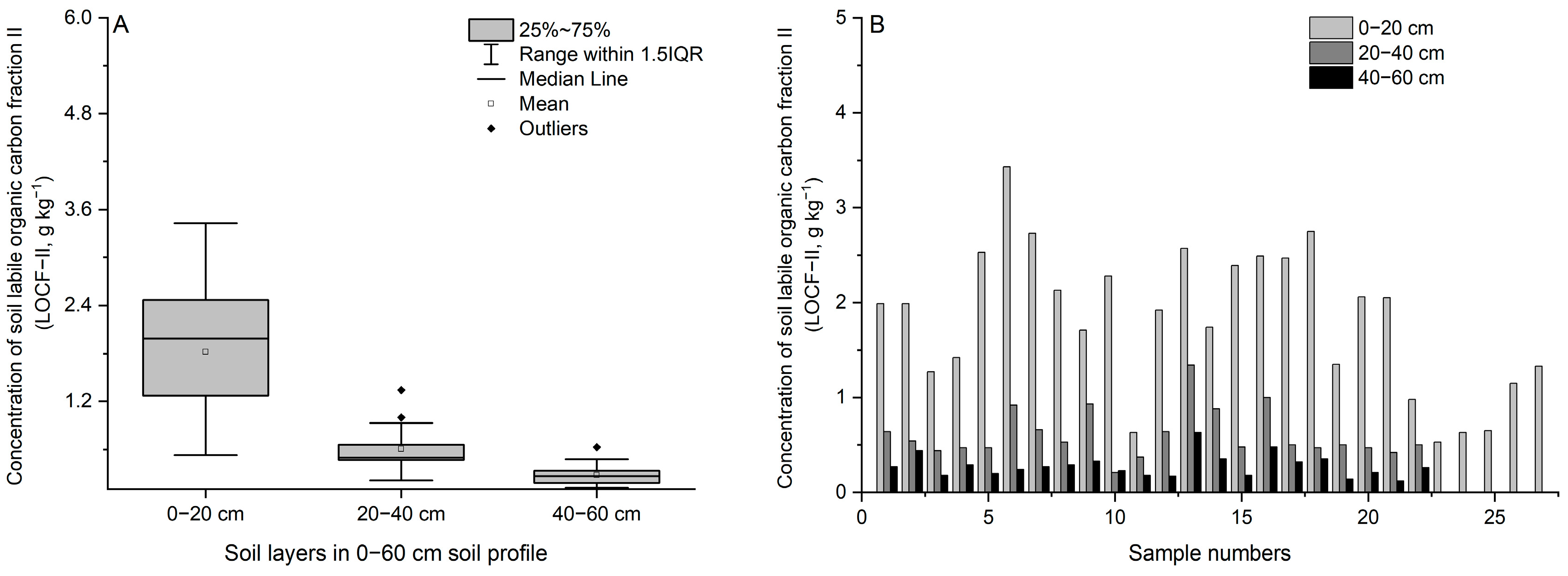

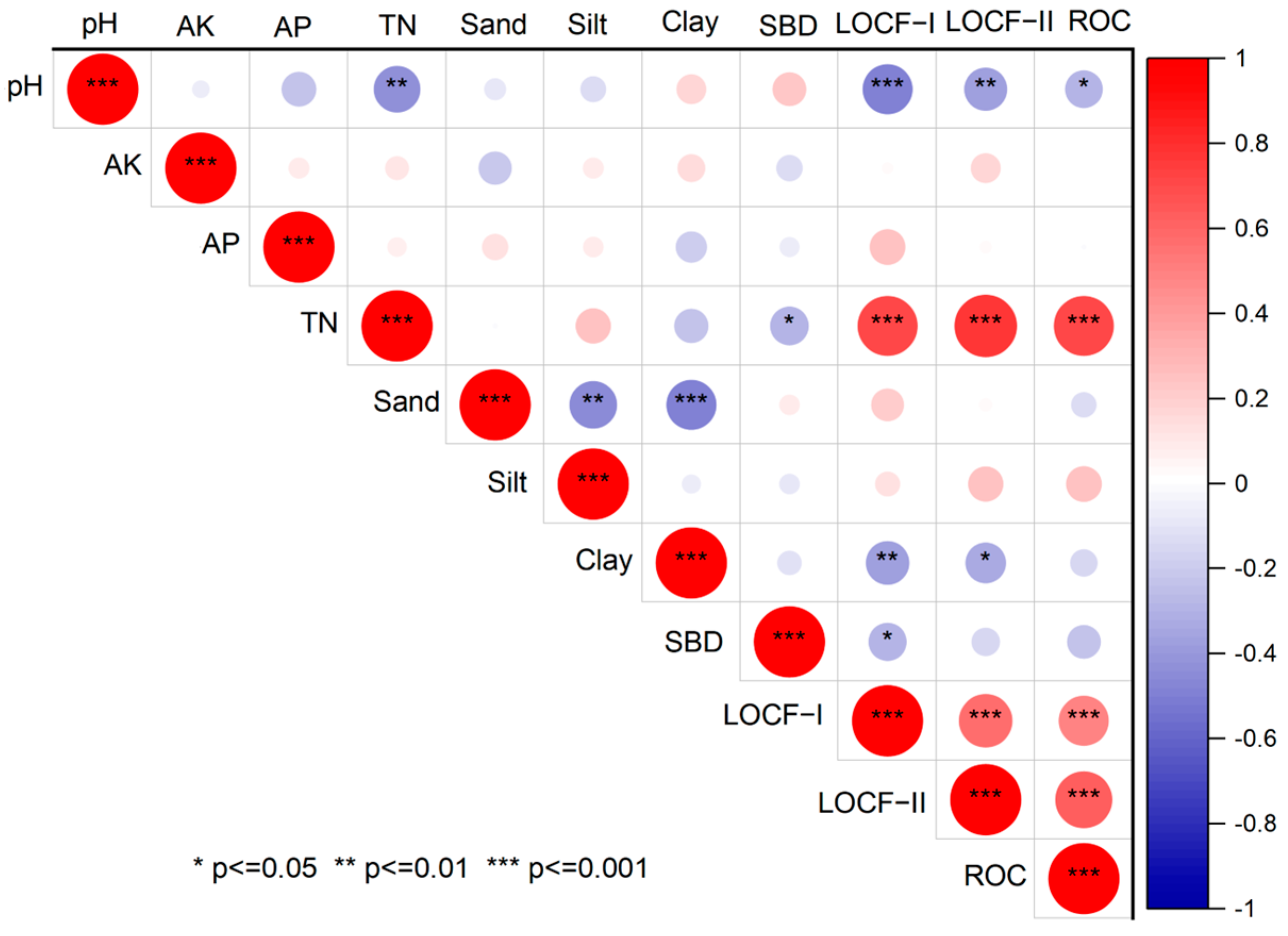
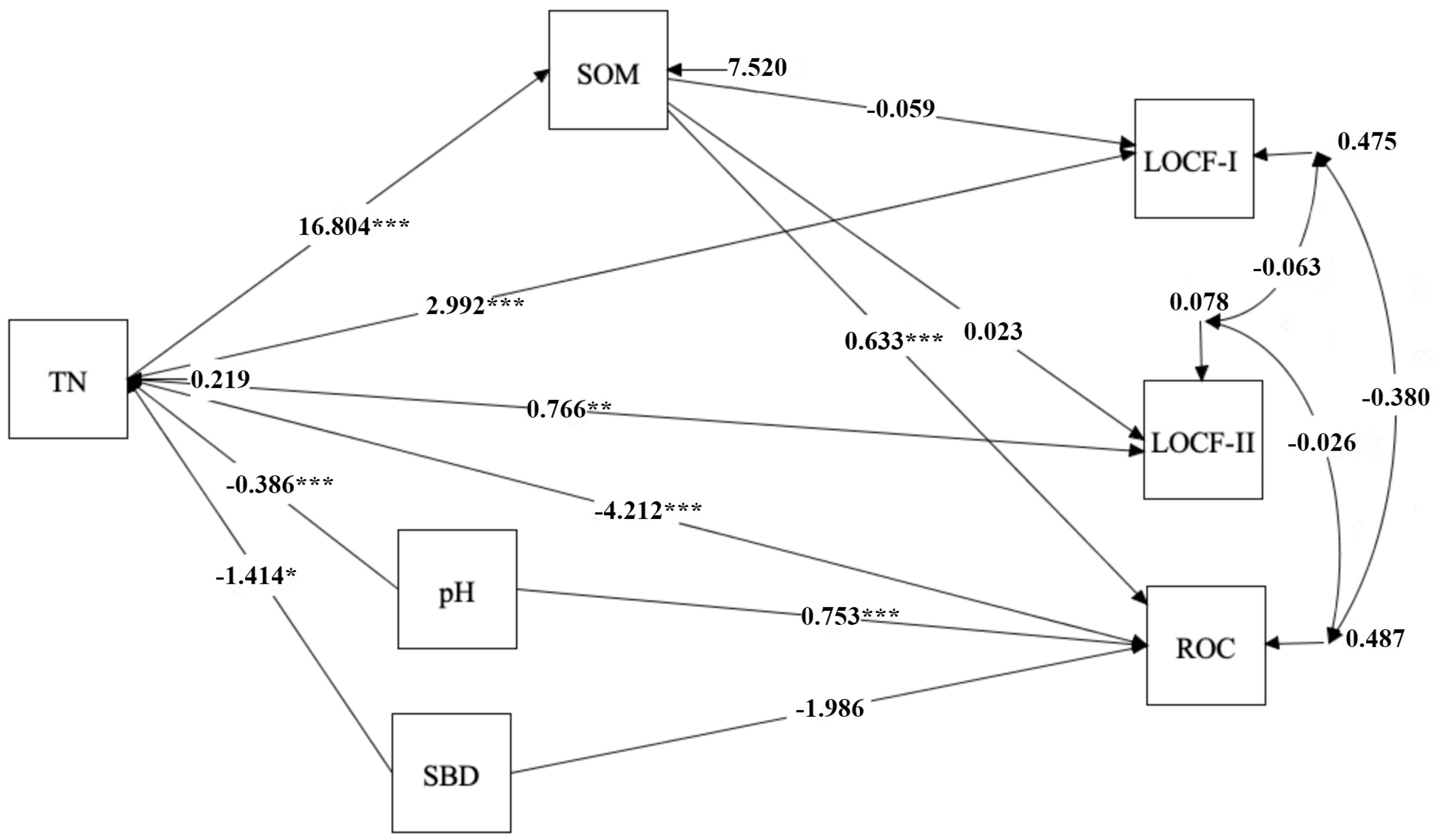
| Parameters | pH | Total N | Available P | Available K | Sand | Silt | Clay | SBD (g cm−3) | ||
|---|---|---|---|---|---|---|---|---|---|---|
| (g kg−1) | (mg kg−1) | (mg kg−1) | (%) | (%) | (%) | 0–20 cm | 20–40 cm | 40–60 cm | ||
| Mean | 5.68 | 29.70 | 36.65 | 83.50 | 43.07 | 39.64 | 17.29 | 1.31 | 1.58 | 1.50 |
| Median | 5.48 | 1.64 | 29.36 | 66.66 | 46.2 | 42.0 | 16.0 | 1.33 | 1.59 | 1.53 |
| Range | 4.66~7.77 | 10.74–50.45 | 4.83–120.85 | 35.54–220.63 | 17.2–70.4 | 15.6–53 | 4.0–49.2 | 0.99–1.76 | 1.24–1.88 | 1.11–1.85 |
| ** C.V. (%) | 5.68 | 34.96 | 68.74 | 58.81 | 30.89 | 25.83 | 17.29 | 12.37 | 11.91 | 14.18 |
| Soil Layer | Min (t hm−2) | Max (t hm−2) | Mean (t hm−2) | SD * |
|---|---|---|---|---|
| 0–20 cm | 16.47 | 66.71 | 44.58 | 13.91 |
| 20–40 cm | 7.47 | 45.06 | 19.08 | 9.56 |
| 40–60 cm | 3.13 | 23.11 | 11.34 | 5.00 |
| Soil Layer | Labile Organic Carbon Fraction I (LOCF-I) | ||
|---|---|---|---|
| Concentration (g kg−1) | Stock (t hm−2) | Proportion (%) | |
| 0–20 cm | 3.78 | 9.54 | 59.03 |
| 20–40 cm | 1.28 | 4.09 | 25.31 |
| 40–60 cm | 0.87 | 2.53 | 15.66 |
| Layer | Labile Organic Carbon Fraction II (LOCF-II) | ||
|---|---|---|---|
| Concentration (g kg−1) | Stock (t hm−2) | Proportion (%) | |
| 0–20 cm | 1.82 | 4.69 | 63.12 |
| 20–40 cm | 0.61 | 1.93 | 25.98 |
| 40–60 cm | 0.28 | 0.81 | 10.90 |
| Soil Layer | Recalcitrant Organic Carbon (ROC) | ||
|---|---|---|---|
| Concentration (g kg−1) | Stock (t hm−2) | Proportion (%) | |
| 0–20 cm | 11.78 | 30.36 | 59.03 |
| 20–40 cm | 4.17 | 13.06 | 25.40 |
| 40–60 cm | 2.83 | 8.01 | 15.57 |
| Soil Layer | LOCF-I | LOCF-II | ROC | |||
|---|---|---|---|---|---|---|
| Contents | Proportion (%) | Contents | Proportion (%) | Contents | Proportion (%) | |
| 0–20 cm | 3.74 ± 1.65 | 21.75 ± 6.13 | 1.82 ± 0.76 | 10.35 ± 2.09 | 11.78 ± 4.10 | 67.89 ± 6.85 |
| 20–40 cm | 1.28 ± 0.74 | 22.06 ± 11.26 | 0.61 ± 0.26 | 10.63 ± 2.41 | 4.17 ± 2.21 | 67.31 ± 6.85 |
| 40–60 cm | 0.87 ± 0.35 | 21.98 ± 12.22 | 0.28 ± 0.12 | 7.70 ± 2.34 | 2.83 ± 1.87 | 70.31 ± 7.38 |
Disclaimer/Publisher’s Note: The statements, opinions and data contained in all publications are solely those of the individual author(s) and contributor(s) and not of MDPI and/or the editor(s). MDPI and/or the editor(s) disclaim responsibility for any injury to people or property resulting from any ideas, methods, instructions or products referred to in the content. |
© 2024 by the authors. Licensee MDPI, Basel, Switzerland. This article is an open access article distributed under the terms and conditions of the Creative Commons Attribution (CC BY) license (https://creativecommons.org/licenses/by/4.0/).
Share and Cite
Hu, L.; Zeng, R.; Yao, J.; Liang, Z.; Zeng, Z.; Li, W.; Wang, R.; Shu, X.; Chen, Y.; Ning, J. Characteristics of the Soil Organic Carbon Pool in Paddy Fields in Guangdong Province, South China. Agriculture 2024, 14, 1457. https://doi.org/10.3390/agriculture14091457
Hu L, Zeng R, Yao J, Liang Z, Zeng Z, Li W, Wang R, Shu X, Chen Y, Ning J. Characteristics of the Soil Organic Carbon Pool in Paddy Fields in Guangdong Province, South China. Agriculture. 2024; 14(9):1457. https://doi.org/10.3390/agriculture14091457
Chicago/Turabian StyleHu, Lijiang, Ruikun Zeng, Jianwu Yao, Ziwei Liang, Zhaobing Zeng, Wenying Li, Ronghui Wang, Xianjiang Shu, Yong Chen, and Jianfeng Ning. 2024. "Characteristics of the Soil Organic Carbon Pool in Paddy Fields in Guangdong Province, South China" Agriculture 14, no. 9: 1457. https://doi.org/10.3390/agriculture14091457





